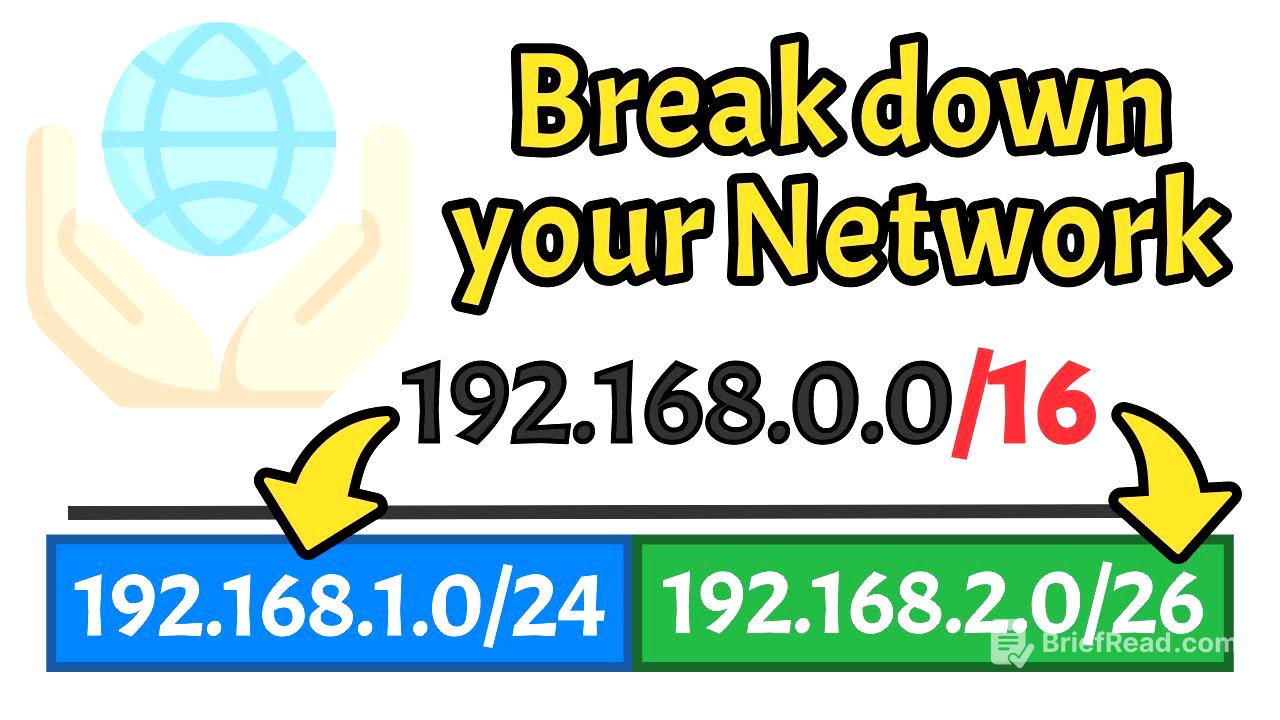TLDR;
This video explains subnetting, the process of dividing a large network into smaller, manageable subnetworks to optimize performance, efficiently allocate IP addresses, and enhance security. It covers IP addresses, subnet masks, IP address classes (A, B, C, D, and E), subnetting calculations, CIDR notation, and the differences between classful and classless subnetting. The video also highlights common subnetting scenarios, potential pitfalls, and best practices for effective network management.
- Subnetting divides large networks into smaller subnets for better management and efficiency.
- IP addresses and subnet masks are essential for identifying devices and defining network/host portions.
- Classless subnetting (CIDR) offers more flexibility than classful subnetting.
- Proper documentation and planning are crucial for avoiding pitfalls in subnetting.
Intro [0:00]
The video introduces the concept of subnetting as a method to divide large networks into smaller, more manageable subnets. It highlights the importance of subnetting in optimizing network performance, efficiently allocating IP addresses, and enhancing security within organizations. The video promises to simplify the understanding of subnetting through whiteboard animations.
What is Subnetting? [0:28]
Subnetting is defined as the process of dividing a larger network into smaller subnetworks or subnets. This breakdown helps in organizing and efficiently allocating IP addresses, preventing the waste of IP resources. Subnetting enhances network performance by reducing traffic congestion and improves security by isolating different parts of a network. It also allows network administrators to better manage and control access within different areas of a network, making it easier to troubleshoot and maintain. Each subnet operates independently while remaining part of the larger network, ensuring efficient communication between devices.
IP Addresses & Subnet Masks [1:11]
An IP address is a unique numerical label assigned to each device connected to a network, enabling communication between devices. It serves as a digital address to identify and locate devices within a network or across the internet. IP addresses come in two versions: IPv4, consisting of four sets of numbers, and IPv6, which uses a longer format. Subnet masks are crucial for determining how an IP address is split between the network and host portions. A subnet mask consists of a sequence of numbers that tells the device how much of the IP address belongs to the network and how much is reserved for the individual device.
IP Address Classes [2:12]
IP address classes categorize IP addresses based on their range and intended use, providing a structured approach to allocating addresses within a network. The primary classes are Class A, B, C, D, and E. Class A addresses are for very large networks (up to 16 million hosts), Class B for medium-sized networks (up to 65,000 hosts), and Class C for small networks (up to 254 hosts). Class D addresses are reserved for multicast groups, and Class E addresses are reserved for experimental purposes and research. The range between 126.0.0.0 and 128.0.0.0 includes IP addresses which are part of Class A but are primarily reserved for loopback addresses, with 127.0.0.1 commonly used as localhost.
Subnetting Calculation [3:54]
Basic subnetting calculations require the original IP address and the subnet mask. Converting the subnet mask into binary reveals the division between the network and host portions. The number of zeroes in the subnet mask determines the number of possible hosts, calculated using the formula 2^n, where n is the number of bits allocated for the host portion. The first address is reserved for the network ID, and the last address is reserved for the broadcast address, leaving 254 usable IP addresses. More zeroes in the subnet mask mean more hosts can be supported, while more ones mean fewer hosts but more subnets, calculated using the formula 2^m, where m is the number of bits borrowed from the host portion to create subnets.
Reading & Interpreting Subnetting [5:52]
Reading and interpreting subnetting involves identifying key elements like the network address, broadcast address, and the range of usable IP addresses. This is commonly represented through CIDR (Classless Inter-Domain Routing) notation, which combines the IP address with a suffix indicating the number of network bits in the subnet mask. For example, 192.168.10.15/24 indicates that the first 24 bits belong to the network portion. The network address is determined by setting all host bits to zero, and the broadcast address is determined by setting all host bits to one. The range of usable IP addresses falls between these two values.
Common Subnetting Scenarios [7:16]
Common subnetting scenarios include dividing a large corporate network into smaller subnets to enhance security and reduce congestion, such as separating administrative, engineering, and guest networks. Allocating subnets based on geographic locations enables remote offices to communicate effectively while maintaining separation from the main corporate network. Organizations often implement subnets to accommodate growth, creating new subnets as the number of devices increases. Internet service providers frequently use subnetting to manage their IP address space effectively, distributing ranges to customers while ensuring optimal utilization and avoiding address wastage.
Classful vs Classless Subnetting [8:25]
Classful subnetting uses fixed IP address classes (A, B, C, D, and E), each with a predefined subnet mask, limiting flexibility in allocating address spaces. This often leads to inefficient use of IP addresses. Classless subnetting, known as CIDR, allows for more flexibility by letting you choose any number of bits for the network portion of an IP address, helping allocate IP address space more efficiently, minimizing waste, and improving network scalability. CIDR also enhances routing efficiency by reducing the size of routing tables, making it the preferred method in modern networks.
Pitfalls & Best Practices [9:33]
Potential pitfalls in managing IP address allocation and subnetting include neglecting to document subnet configurations, which can lead to confusion and inefficient management. It's essential to maintain clear records of assigned IP ranges, subnet masks, and the purpose of each subnet. Another pitfall is failing to consider future growth; organizations should plan their subnetting with scalability in mind. Best practices include adopting a hierarchical addressing scheme to enhance routing efficiency and simplify network management, as well as regularly reviewing and updating address assignments to avoid conflicts and ensure optimal utilization of IP address space.
Conclusions [10:34]
Understanding subnetting is crucial for optimizing network performance and efficient IP address management. By grasping the fundamentals of subnetting calculations, interpreting CIDR notation, and recognizing the differences between classful and classless systems, network administrators can design networks that are both scalable and efficient. Adhering to best practices, such as thorough documentation, planning for future growth, and regular reviews, can significantly reduce errors and enhance network performance, ensuring networks remain robust and adaptable to changing needs.
Outro [11:14]
The video concludes by thanking viewers and encouraging them to subscribe to the channel, like the video, and check out other related videos.









![Doctor Who: Once and Future - Hit or Miss? [SPOILERS]](https://wm-img.halpindev.com/p-briefread_c-10_b-10/urlb/aHR0cDovL2ltZy55b3V0dWJlLmNvbS92aS9KNmhYQTBBTHg2cy9ocWRlZmF1bHQuanBn.jpg)